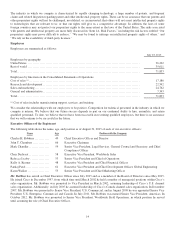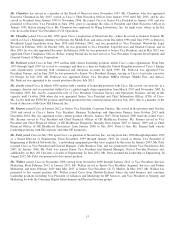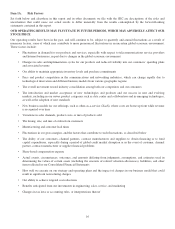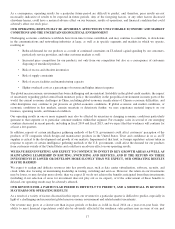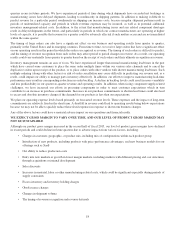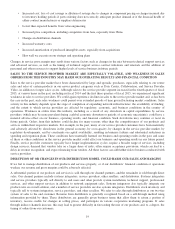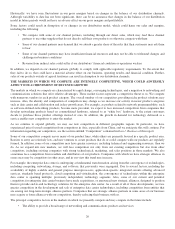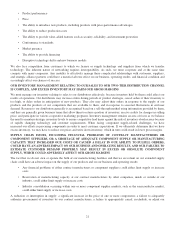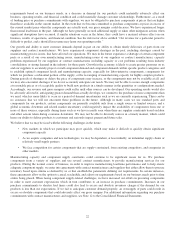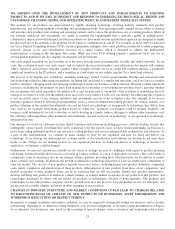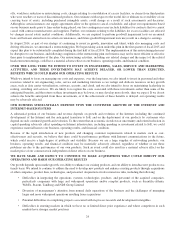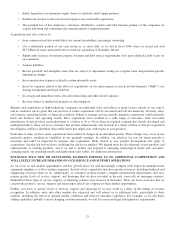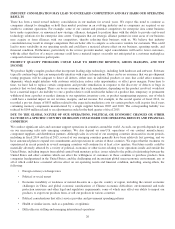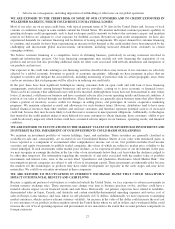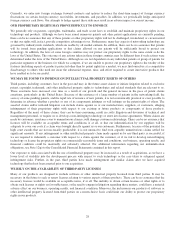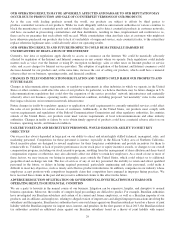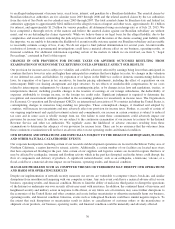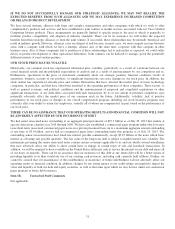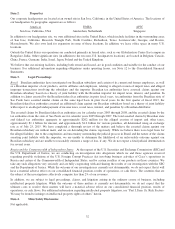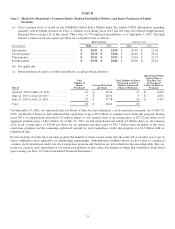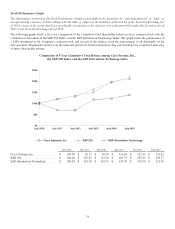Cisco 2015 Annual Report Download - page 32
Download and view the complete annual report
Please find page 32 of the 2015 Cisco annual report below. You can navigate through the pages in the report by either clicking on the pages listed below, or by using the keyword search tool below to find specific information within the annual report.offs, workforce reduction or restructuring costs, charges relating to consolidation of excess facilities, or claims from third parties
who were resellers or users of discontinued products. Our estimates with respect to the useful life or ultimate recoverability of our
carrying basis of assets, including purchased intangible assets, could change as a result of such assessments and decisions.
Although in certain instances our supply agreements allow us the option to cancel, reschedule, and adjust our requirements based
on our business needs prior to firm orders being placed, our loss contingencies may include liabilities for contracts that we cannot
cancel with contract manufacturers and suppliers. Further, our estimates relating to the liabilities for excess facilities are affected
by changes in real estate market conditions. Additionally, we are required to perform goodwill impairment tests on an annual
basis and between annual tests in certain circumstances, and future goodwill impairment tests may result in a charge to earnings.
In August 2014, as part of our strategy of continuing to invest in growth, innovation and talent, while also managing costs and
driving efficiencies, we announced a restructuring plan. We began taking action under this plan in the first quarter of fiscal 2015 and
expect this plan to be substantially completed during the first half of fiscal 2016. The implementation of this restructuring plan may
be disruptive to our business, and following completion of the restructuring plan our business may not be more efficient or effective
than prior to implementation of the plan. Our restructuring activities, including any related charges and the impact of the related
headcount restructurings, could have a material adverse effect on our business, operating results, and financial condition.
OVER THE LONG TERM WE INTEND TO INVEST IN ENGINEERING, SALES, SERVICE AND MARKETING
ACTIVITIES, AND THESE INVESTMENTS MAY ACHIEVE DELAYED, OR LOWER THAN EXPECTED,
BENEFITS WHICH COULD HARM OUR OPERATING RESULTS
While we intend to focus on managing our costs and expenses, over the long term, we also intend to invest in personnel and other
resources related to our engineering, sales, service and marketing functions as we realign and dedicate resources on key growth
areas, such as data center virtualization, software, security, and cloud, and we also intend to focus on maintaining leadership in
routing, switching and services. We are likely to recognize the costs associated with these investments earlier than some of the
anticipated benefits, and the return on these investments may be lower, or may develop more slowly, than we expect. If we do not
achieve the benefits anticipated from these investments, or if the achievement of these benefits is delayed, our operating results
may be adversely affected.
OUR BUSINESS SUBSTANTIALLY DEPENDS UPON THE CONTINUED GROWTH OF THE INTERNET AND
INTERNET-BASED SYSTEMS
A substantial portion of our business and revenue depends on growth and evolution of the Internet, including the continued
development of the Internet and the anticipated transition to IoE, and on the deployment of our products by customers who
depend on such continued growth and evolution. To the extent that an economic slowdown or uncertainty and related reduction in
capital spending adversely affect spending on Internet infrastructure, including spending or investment related to IoE, we could
experience material harm to our business, operating results, and financial condition.
Because of the rapid introduction of new products and changing customer requirements related to matters such as cost-
effectiveness and security, we believe that there could be performance problems with Internet communications in the future,
which could receive a high degree of publicity and visibility. Because we are a large supplier of networking products, our
business, operating results, and financial condition may be materially adversely affected, regardless of whether or not these
problems are due to the performance of our own products. Such an event could also result in a material adverse effect on the
market price of our common stock independent of direct effects on our business.
WE HAVE MADE AND EXPECT TO CONTINUE TO MAKE ACQUISITIONS THAT COULD DISRUPT OUR
OPERATIONS AND HARM OUR OPERATING RESULTS
Our growth depends upon market growth, our ability to enhance our existing products, and our ability to introduce new products on a
timely basis. We intend to continue to address the need to develop new products and enhance existing products through acquisitions
of other companies, product lines, technologies, and personnel. Acquisitions involve numerous risks, including the following:
• Difficulties in integrating the operations, systems, technologies, products, and personnel of the acquired companies,
particularly companies with large and widespread operations and/or complex products, such as Scientific-Atlanta,
WebEx, Starent, Tandberg and NDS Group Limited
• Diversion of management’s attention from normal daily operations of the business and the challenges of managing
larger and more widespread operations resulting from acquisitions
• Potential difficulties in completing projects associated with in-process research and development intangibles
• Difficulties in entering markets in which we have no or limited direct prior experience and where competitors in such
markets have stronger market positions
24


